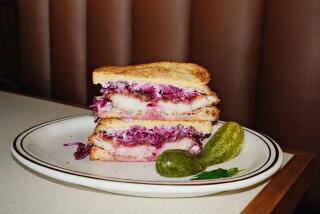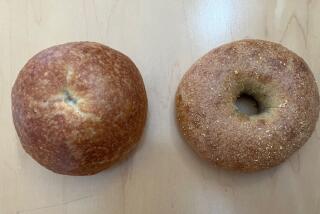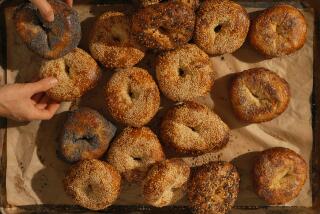Daniel Thompson dies at 94; his invention made bagel a household word
From his earliest childhood days, Daniel Thompson watched his father pursue an unusual obsession: building a bagel-making machine.
The senior Thompson ran a Boyle Heights bakery, where he made bagels the way they had always been made — by hand. Believing a machine would help expand the market for the beloved Jewish staple, he spent decades designing one contraption after another, but they were slow, persnickety and too often produced what his son called “hockey pucks with holes.”
In the 1950s, Thompson started tinkering on his own. Four decades after his father began the quest, he perfected the machine and helped turn bagel into a household word.
Thompson, who invented a commercially viable bagel-making machine and became a key figure behind what some have called “the industrialization of the bagel,” died Sept. 3 in Palm Desert after a fall, his family said. He was 94.
In 1958, the former junior high school teacher started building the prototype of what became the Thompson Bagel Machine in his Cheviot Hills garage. Five years later, he leased the first one to another visionary, Murray Lender, whose family-run business in New Haven, Conn., introduced the first line of frozen bagels.
With Thompson’s machine, Lender’s Bagels began mass producing the homely O-shaped bread, and other bakers soon joined the movement. Purists complained that automation changed the character of the bagel for the worse, but within a decade, the ethnic favorite went mainstream, sold in stores across the country and paving the way for the proliferation of neighborhood bagel shops and varieties.
“Today, everybody loves bagels. It’s no more ethnic than pizza is,” the aptly named Marilyn Bagel, co-author of “The Bagel Bible: For Bagel Lovers, the Complete Guide to Bagel Noshing,” said in an interview last week. “Daniel Thompson was monumental in that regard.”
Bagels were brought to America in the 1880s by Eastern European Jews. Clustered in New York City, bagel bakers passed recipes from fathers to sons. They formed a union shortly after the turn of the century.
The bagels typically were made by a team of four men, who rolled and shaped the dough before it was boiled and baked.
For his machine, Thompson borrowed some of his father’s ideas, but his design was simpler and faster. His major innovation was the addition of cups that help form the dough into a circle and open to release it onto a conveyor belt or turntable.
His company turned a profit in 1964, the year after Lender’s adopted the technology, and is still in business, run by son Stephen.
The advent of the machines sparked protests by union members, but theirs was a losing battle. “Within a few years, almost every major bagel baker in America was using Thompson’s machine,” Gil Marks wrote in the “Encyclopedia of Jewish Food.” There was no way the fastest bagel man could beat it.
“You used to have two guys hand-shaping and boiling and baking who could turn out maybe 120 bagels an hour,” Thompson told the New York Times in 1993. But the machine, he said, “rolls 200 to 400 dozen bagels an hour.”
His largest machines produce 5,000 an hour, according to son Craig Thompson, the company’s designer and machinist
Daniel Thompson was born Jan. 16, 1921, in Winnipeg, Canada. It was there that his father, Mickey, began to envision what mechanization could do for his bakery business. He patented his first bagel machine a few years before his son’s birth.
“My father was thinking about a bagel-making machine when I was conceived,” Thompson often joked.
Before Thompson turned 1, his father moved the family to Los Angeles and soon established the bakery in Boyle Heights, then the heart of the city’s Jewish community. He worked on his prototypes for the bagel machine in his garage, enlisting Thompson’s help at 11.
“I resented missing a lot of baseball games and not being able to play with my friends,” Thompson later wrote in a history of his bagel machine, “but I understood what my father was attempting to accomplish and I did not complain. I learned that things could be accomplished without the proper tools, substituting sheer sweat and determination.”
After graduating from Fairfax High School, Thompson served as a navigator-bombardier in the Army Air Force, seeing combat in the Pacific during World War II.
He married Ada Schatz in 1946. She survives him, along with their two sons, daughter Leslie, and three grandchildren.
When Thompson completed his military service, he studied industrial arts and mathematics at UCLA. Over the next decade, he taught shop at Bancroft Junior High and math and science at Westchester High.
The bagel machine was not his first invention.
In 1950, he and his wife were visiting friends when one of them mentioned pingpong. It was one of Thompson’s favorite games but, as he told friends, he hated assembling and breaking down the heavy table every time he played.
“He said there must be a better way,” Ada Thompson recalled last week, “so he sat down with a pad of paper and started sketching.”
Twenty minutes later, she said, he had the design for a folding pingpong table. He patented it in 1953 and sold the rights to a major manufacturer. The proceeds from the sale became “the kick-starter, financially, for the bagel machine,” Craig Thompson said.
When his prototype for the machine was ready, Daniel Thompson went looking for a company to manufacture it, but the first several turned him down.
“They complimented me on the concept,” he wrote later, “but felt that the bagel market was not large enough to justify the great expense.”
Twitter: @ewooLATimes
More to Read
Start your day right
Sign up for Essential California for the L.A. Times biggest news, features and recommendations in your inbox six days a week.
You may occasionally receive promotional content from the Los Angeles Times.







